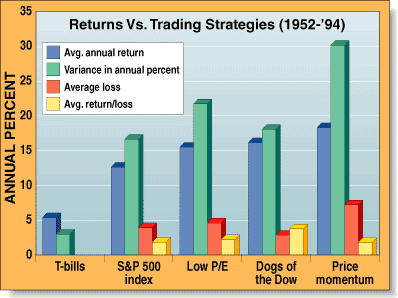TRADING TECHNIQUES
Has Volatility Lost Its Edge?
by Mark G. Levey
Does volatility still offer the same advantage it once did in trading the Standard & Poor's 500 index? Here's a followup to previous STOCKS & COMMODITIES articles.
From a statistical standpoint, assuming an even chance of loss or gain on an investment, low-volatility investments offer significantly higher returns than do high-volatility strategies. A low-volatility trading system beats a high-volatility system 70% to 80% of the time when given the same sequence of trading results. In winning systems, however, game theory shows that once the probability of winning exceeds 56%, high-volatility strategies prevail.

FIGURE 1: RETURNS TO VARIOUS TRADING STRATEGIES. From 1952 to 1994, momentum was the most rewarding strategy, but it came with the highest risk expressed as variance of returns.
In reality, markets do not operate strictly according to random walk theory. Since World War II, average values of stocks and bonds have appreciated overall, making the outcome of long trades over time a better than even bet. In the December 1998 STOCKS & COMMODITIES, Dick Stoken reviewed the outcomes of five trading strategies for assets of varying volatility during the period encompassing 1952-94. Stoken found that the most volatile investment strategy (price momentum with a variance of 30.14) outperformed the least risky (Treasury bills with a variance of 3.01) by an average annual excess return of 12.84%. Measuring excess returns as the average annual returns minus the zero-risk return for T-bills, he arrived at an average excess return to loss ratio (AR/L) for various strategies (Figure 1).
During the period Stoken studied, US securities markets presented an exception to the normal GaussianÝ rule of evenly distributed outcomes suggested by the efficient market hypothesis (EMH), which implies that over the long run it is impossible to beat the market. Long-term outcomes of different trading strategies should be no better than random picks. Over time, losses should cancel out any systematic gains beyond the general market, according to EMH theory.
A BETTER GUIDE?
When you factor in the enormous rise of the Standard & Poor's 500 index during the last five years, the EMH may seem like a better guide to actual market behavior. In fact, the overall market has performed better than most systematic trading strategies, particularly those that attempt to hedge risks. Since 1995, returns from low-loss, low-volatility strategies -- particularly T-bills and the dogs of the Dow -- have fallen even further behind the index-riding and momentum investment approaches. While the S&P 500 more than doubled between 1995 to 1999, the dogs -- the 10 most underperforming members of the Dow 30 -- lagged behind with a 61.5% gain. Since 1995, T-bills have shown less than a 30% overall return.
Mark G. Levey is a senior researcher with the law firm of Cameron & Hornbostel in Washington, DC.
Excerpted from an article originally published in the May 2000 issue of Technical Analysis of STOCKS & COMMODITIES magazine. All rights reserved. © Copyright 2000, Technical Analysis, Inc.
Return to May 2000 Contents